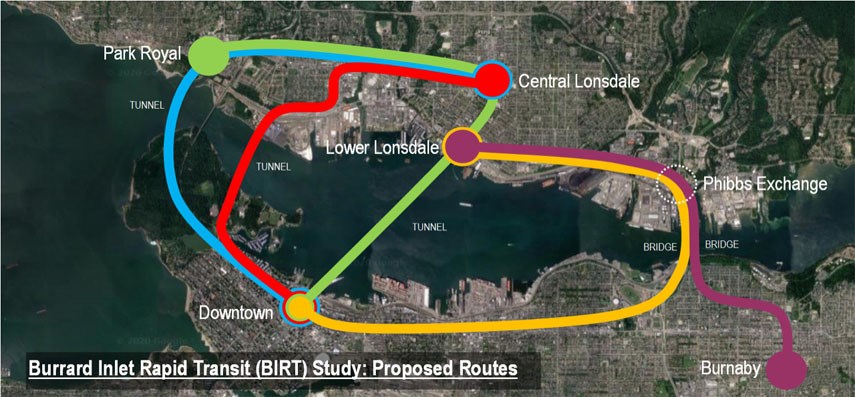The province has narrowed down the options it may consider for a rapid transit link connecting the North Shore to Vancouver and beyond.
The Ministry of Transportation and Infrastructure released Phase 2 of their study into the Burrard Inlet Rapid Transit link Tuesday, showing five bridge and tunnel options that are at least technically feasible.
All of the options originate along the Lonsdale corridor but then take different routes to connect to existing rapid transit lines in Vancouver or Burnaby.
Tunnelling under the First Narrows, either via Park Royal or the Norgate area to Burrard SkyTrain station can be done, the engineers’ report says, but more study into the geology and existing underground infrastructure would have to be done.
To the east, there are two contenders for crossing the Second Narrows via a new rapid transit bridge that either links the line in with the Millennium Line’s Brentwood Station or turns west and runs back downtown via a new line along Hastings Street.
Engineers did explore using the existing Ironworkers Memorial Second Narrows Crossing structure to hold a rail line underneath, but they screened the idea out because the bridge is not up to modern seismic or ship impact standards.
A straight shot under the inlet from Lonsdale to Waterfront Station was deemed infeasible because the inlet is so deep, the grades of the track and tunnel would be more akin to a roller coaster than public transit, which has a max grade of six per cent. A terminus at Waterfront would have to be 50 to 60 metres below the surface. But a second option of connecting to Yaletown Roundhouse station would be technically possible; however, it would require rebuilding more than a kilometre of the existing Canada Line to lower it another 20 to 35 metres.
With the second phase of the study complete, it’s now up to TransLink staff to analyze which options would work best within transit system as a whole in terms of ridership, and get down to more detailed studies.
North Vancouver-Lonsdale MLA Bowinn Ma, whose Integrated North Shore Transportation Planning Project called for the BIRT study in 2018, said she was surprised so many options made the short-list but, she added, she was pleased.
“I think that's good news for the North Shore. It means that there are multiple options for us to put into TransLink’s Transport 2050 process, which gives us a higher chance of finding a potential route option that performs well in the their network analysis,” she said.
Ma said she doesn’t want to name a favourite out of the options presented but, she said, she doesn’t foresee any of them replacing the SeaBus.
Because of rapidly changing construction and land prices, the study did not contain even notional costs, although Ma said there is no question all of the options will be in the billions.
The federal government, meanwhile, has put up funds so the North Shore can prepare a business case for the BIRT before it goes to the TransLink mayors’ council for consideration among all other transit expansion projects from across the region.
Ma said it is critical that North Shore residents and commuters find ways of getting around that are both socially and environmentally responsible.
“We can’t build a rapid transit line in the future if we don't start looking at it now,” she said. “These are first steps. There is a lot of work ahead of us, but we have to take these steps if we're going to get anywhere.”
The BIRT study was funded by the province, three North Shore municipalities and by the City of Vancouver.



